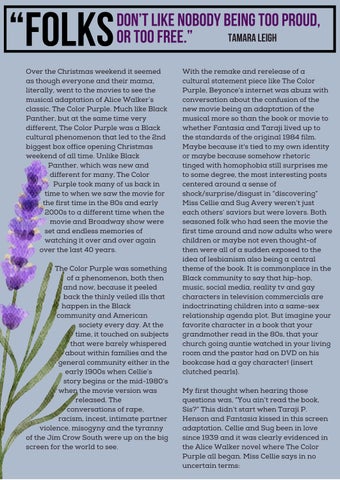“Folks
don’t like nobody being too proud, tamara leigh or too free.”
Over the Christmas weekend it seemed as though everyone and their mama, literally, went to the movies to see the musical adaptation of Alice Walker’s classic, The Color Purple. Much like Black Panther, but at the same time very different, The Color Purple was a Black cultural phenomenon that led to the 2nd biggest box office opening Christmas weekend of all time. Unlike Black Panther, which was new and different for many, The Color Purple took many of us back in time to when we saw the movie for the first time in the 80s and early 2000s to a different time when the movie and Broadway show were set and endless memories of watching it over and over again over the last 40 years. The Color Purple was something of a phenomenon, both then and now, because it peeled back the thinly veiled ills that happen in the Black community and American society every day. At the time, it touched on subjects that were barely whispered about within families and the general community either in the early 1900s when Cellie’s story begins or the mid-1980’s when the movie version was released. The conversations of rape, racism, incest, intimate partner violence, misogyny and the tyranny of the Jim Crow South were up on the big screen for the world to see.
With the remake and rerelease of a cultural statement piece like The Color Purple, Beyonce’s internet was abuzz with conversation about the confusion of the new movie being an adaptation of the musical more so than the book or movie to whether Fantasia and Taraji lived up to the standards of the original 1984 film. Maybe because it's tied to my own identity or maybe because somehow rhetoric tinged with homophobia still surprises me to some degree, the most interesting posts centered around a sense of shock/surprise/disgust in “discovering” Miss Cellie and Sug Avery weren’t just each others’ saviors but were lovers. Both seasoned folk who had seen the movie the first time around and now adults who were children or maybe not even thought-of then were all of a sudden exposed to the idea of lesbianism also being a central theme of the book. It is commonplace in the Black community to say that hip-hop, music, social media, reality tv and gay characters in television commercials are indoctrinating children into a same-sex relationship agenda plot. But imagine your favorite character in a book that your grandmother read in the 80s, that your church going auntie watched in your living room and the pastor had on DVD on his bookcase had a gay character! {insert clutched pearls}. My first thought when hearing those questions was, “You ain’t read the book, Sis?” This didn’t start when Taraji P. Henson and Fantasia kissed in this screen adaptation. Cellie and Sug been in love since 1939 and it was clearly evidenced in the Alice Walker novel where The Color Purple all began. Miss Cellie says in no uncertain terms:



